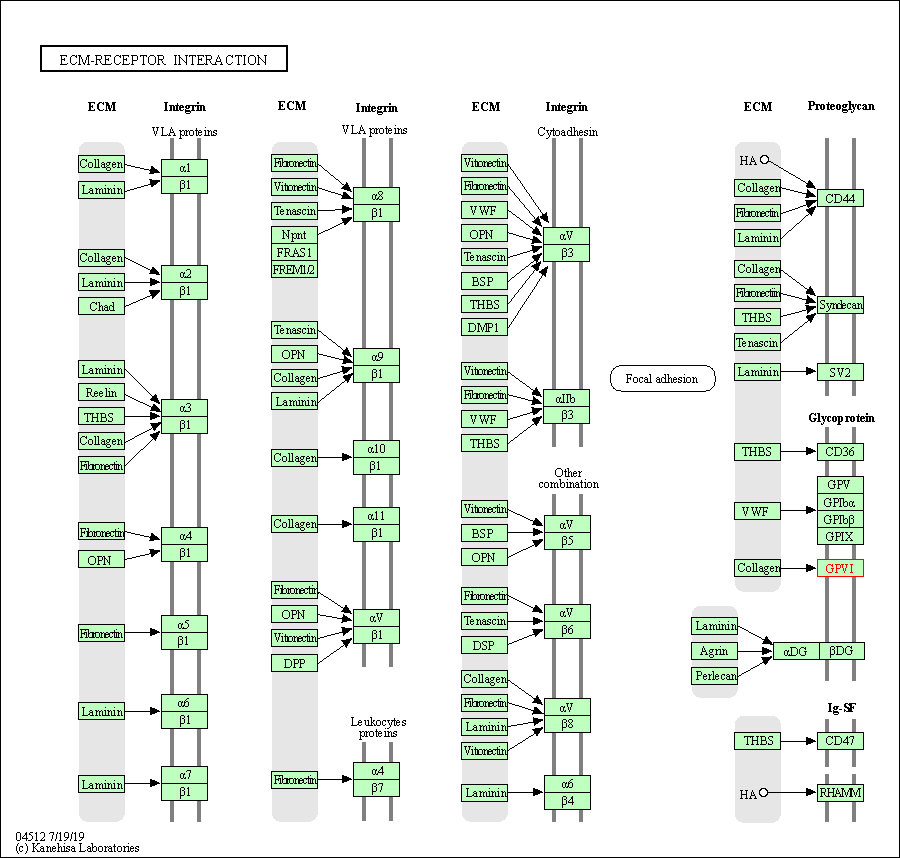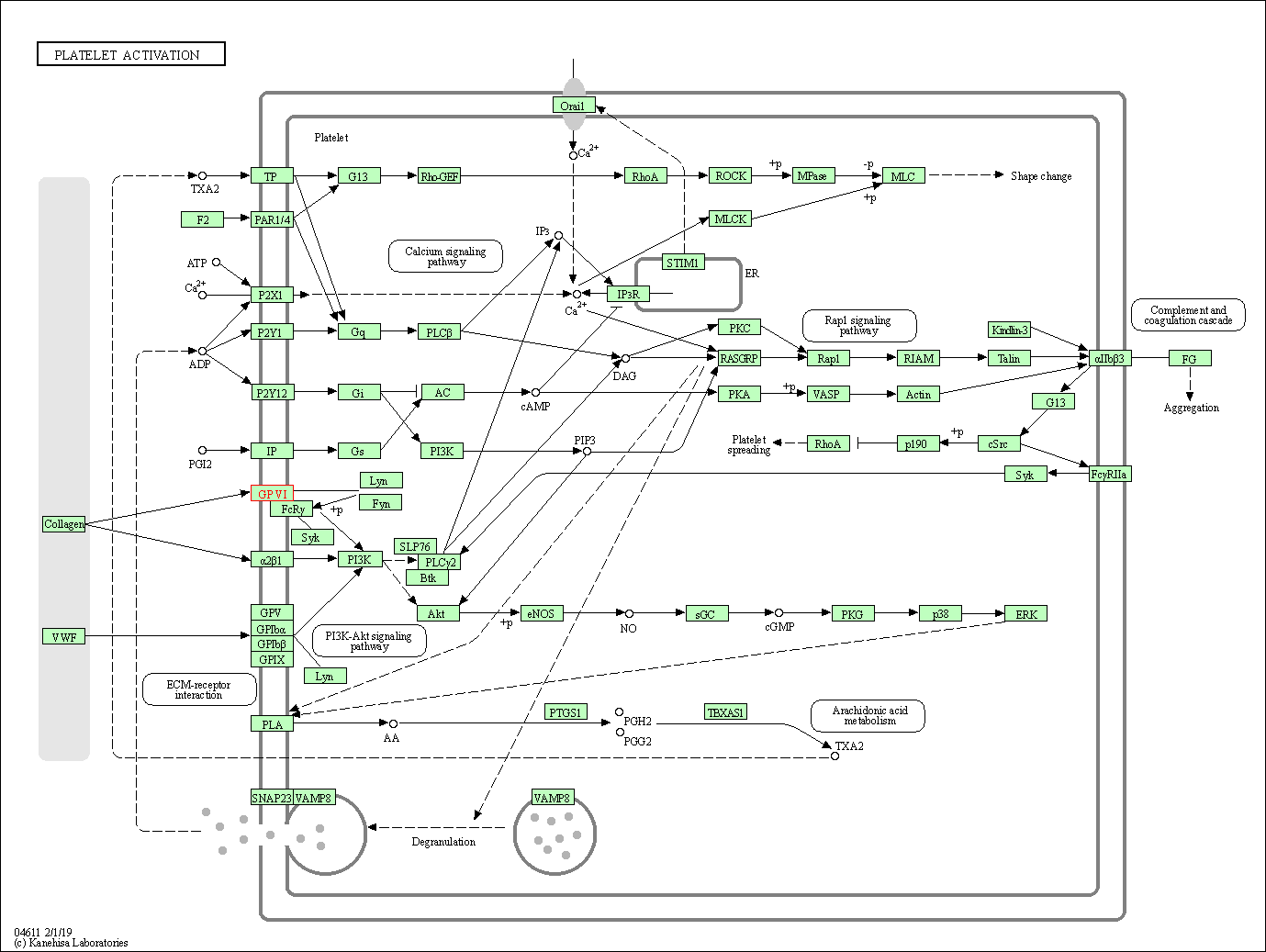Target Information
| Target General Information | Top | |||||
|---|---|---|---|---|---|---|
| Target ID |
T60514
(Former ID: TTDI02085)
|
|||||
| Target Name |
Platelet glycoprotein VI (GP6)
|
|||||
| Synonyms |
Glycoprotein 6; GPVI
Click to Show/Hide
|
|||||
| Gene Name |
GP6
|
|||||
| Target Type |
Clinical trial target
|
[1] | ||||
| Disease | [+] 2 Target-related Diseases | + | ||||
| 1 | Arterial occlusive disease [ICD-11: BD40] | |||||
| 2 | Cerebral ischaemic stroke [ICD-11: 8B11] | |||||
| Function |
Collagen receptor involved in collagen-induced platelet adhesion and activation. Plays a key role in platelet procoagulant activity and subsequent thrombin and fibrin formation. This procoagulant function may contribute to arterial and venous thrombus formation. The signaling pathway involves the FcR gamma-chain, the Src kinases (likely FYN or LYN) and SYK, the adapter protein LAT and leads to the activation of PLCG2.
Click to Show/Hide
|
|||||
| UniProt ID | ||||||
| Sequence |
MSPSPTALFCLGLCLGRVPAQSGPLPKPSLQALPSSLVPLEKPVTLRCQGPPGVDLYRLE
KLSSSRYQDQAVLFIPAMKRSLAGRYRCSYQNGSLWSLPSDQLELVATGVFAKPSLSAQP GPAVSSGGDVTLQCQTRYGFDQFALYKEGDPAPYKNPERWYRASFPIITVTAAHSGTYRC YSFSSRDPYLWSAPSDPLELVVTGTSVTPSRLPTEPPSPVAEFSEATAELTVSFTNEVFT TETSRSITASPKESDSPAGPARQYYTKGNLVRICLGAVILIILAGFLAEDWHSRRKRLRH RGRAVQRPLPPLPPLPLTRKSNGGQDGGRQDVHSRGLCS Click to Show/Hide
|
|||||
| 3D Structure | Click to Show 3D Structure of This Target | AlphaFold | ||||
| HIT2.0 ID | T12PHR | |||||
| Drugs and Modes of Action | Top | |||||
|---|---|---|---|---|---|---|
| Clinical Trial Drug(s) | [+] 2 Clinical Trial Drugs | + | ||||
| 1 | Revacept | Drug Info | Phase 2 | Arteriosclerosis | [2] | |
| 2 | ACT017 | Drug Info | Phase 1/2 | Cerebral ischemia | [3] | |
| Mode of Action | [+] 1 Modes of Action | + | ||||
| Inhibitor | [+] 2 Inhibitor drugs | + | ||||
| 1 | Revacept | Drug Info | [1] | |||
| 2 | ACT017 | Drug Info | [4] | |||
| Cell-based Target Expression Variations | Top | |||||
|---|---|---|---|---|---|---|
| Cell-based Target Expression Variations | ||||||
| Drug Binding Sites of Target | Top | |||||
|---|---|---|---|---|---|---|
| Ligand Name: 2,5,8,11,14,17-Hexaoxaoctadecane | Ligand Info | |||||
| Structure Description | Crystal structure of the Glycoprotein VI loop truncation mutant PAVS-PAPYKN | PDB:5OU7 | ||||
| Method | X-ray diffraction | Resolution | 1.90 Å | Mutation | No | [5] |
| PDB Sequence |
SGPLPKPSLQ
11 ALPSSLVPLE21 KPVTLRCQGP31 PGVDLYRLEK41 LSSSRYQDQA51 VLFIPAMKRS 61 LAGRYRCSYQ71 NGSLWSLPSD81 QLELVATGVF91 AKPSLSAQPG101 SGGDVTLQCQ 111 TRYGFDQFAL121 YKEGDPERWY131 RASFPIITVT141 AAHSGTYRCY151 SFSSRDPYLW 161 SAPSDPLELV171 VTG
|
|||||
|
|
||||||
| Click to View More Binding Site Information of This Target with Different Ligands | ||||||
| Different Human System Profiles of Target | Top |
|---|---|
|
Human Similarity Proteins
of target is determined by comparing the sequence similarity of all human proteins with the target based on BLAST. The similarity proteins for a target are defined as the proteins with E-value < 0.005 and outside the protein families of the target.
A target that has fewer human similarity proteins outside its family is commonly regarded to possess a greater capacity to avoid undesired interactions and thus increase the possibility of finding successful drugs
(Brief Bioinform, 21: 649-662, 2020).
Human Tissue Distribution
of target is determined from a proteomics study that quantified more than 12,000 genes across 32 normal human tissues. Tissue Specificity (TS) score was used to define the enrichment of target across tissues.
The distribution of targets among different tissues or organs need to be taken into consideration when assessing the target druggability, as it is generally accepted that the wider the target distribution, the greater the concern over potential adverse effects
(Nat Rev Drug Discov, 20: 64-81, 2021).
Human Pathway Affiliation
of target is determined by the life-essential pathways provided on KEGG database. The target-affiliated pathways were defined based on the following two criteria (a) the pathways of the studied target should be life-essential for both healthy individuals and patients, and (b) the studied target should occupy an upstream position in the pathways and therefore had the ability to regulate biological function.
Targets involved in a fewer pathways have greater likelihood to be successfully developed, while those associated with more human pathways increase the chance of undesirable interferences with other human processes
(Pharmacol Rev, 58: 259-279, 2006).
Biological Network Descriptors
of target is determined based on a human protein-protein interactions (PPI) network consisting of 9,309 proteins and 52,713 PPIs, which were with a high confidence score of ≥ 0.95 collected from STRING database.
The network properties of targets based on protein-protein interactions (PPIs) have been widely adopted for the assessment of target’s druggability. Proteins with high node degree tend to have a high impact on network function through multiple interactions, while proteins with high betweenness centrality are regarded to be central for communication in interaction networks and regulate the flow of signaling information
(Front Pharmacol, 9, 1245, 2018;
Curr Opin Struct Biol. 44:134-142, 2017).
Human Similarity Proteins
Human Tissue Distribution
Human Pathway Affiliation
Biological Network Descriptors
|
|
|
Note:
If a protein has TS (tissue specficity) scores at least in one tissue >= 2.5, this protein is called tissue-enriched (including tissue-enriched-but-not-specific and tissue-specific). In the plots, the vertical lines are at thresholds 2.5 and 4.
|
| KEGG Pathway | Pathway ID | Affiliated Target | Pathway Map |
|---|---|---|---|
| ECM-receptor interaction | hsa04512 | Affiliated Target |

|
| Class: Environmental Information Processing => Signaling molecules and interaction | Pathway Hierarchy | ||
| Platelet activation | hsa04611 | Affiliated Target |

|
| Class: Organismal Systems => Immune system | Pathway Hierarchy | ||
| Degree | 6 | Degree centrality | 6.45E-04 | Betweenness centrality | 3.52E-05 |
|---|---|---|---|---|---|
| Closeness centrality | 2.16E-01 | Radiality | 1.38E+01 | Clustering coefficient | 2.67E-01 |
| Neighborhood connectivity | 3.78E+01 | Topological coefficient | 2.50E-01 | Eccentricity | 11 |
| Download | Click to Download the Full PPI Network of This Target | ||||
| Chemical Structure based Activity Landscape of Target | Top |
|---|---|
| Target Poor or Non Binders | Top | |||||
|---|---|---|---|---|---|---|
| Target Poor or Non Binders | ||||||
| Target Regulators | Top | |||||
|---|---|---|---|---|---|---|
| Target-interacting Proteins | ||||||
| Target Profiles in Patients | Top | |||||
|---|---|---|---|---|---|---|
| Target Expression Profile (TEP) | ||||||
| Target Affiliated Biological Pathways | Top | |||||
|---|---|---|---|---|---|---|
| KEGG Pathway | [+] 2 KEGG Pathways | + | ||||
| 1 | ECM-receptor interaction | |||||
| 2 | Platelet activation | |||||
| Reactome | [+] 3 Reactome Pathways | + | ||||
| 1 | GPVI-mediated activation cascade | |||||
| 2 | Cell surface interactions at the vascular wall | |||||
| 3 | Platelet Adhesion to exposed collagen | |||||
| WikiPathways | [+] 3 WikiPathways | + | ||||
| 1 | Platelet Adhesion to exposed collagen | |||||
| 2 | GPVI-mediated activation cascade | |||||
| 3 | Cell surface interactions at the vascular wall | |||||
| References | Top | |||||
|---|---|---|---|---|---|---|
| REF 1 | Novel antiplatelet drug revacept (Dimeric Glycoprotein VI-Fc) specifically and efficiently inhibited collagen-induced platelet aggregation without affecting general hemostasis in humans. Circulation.2011 May 3;123(17):1891-9. | |||||
| REF 2 | ClinicalTrials.gov (NCT01645306) Revacept in Symptomatic Carotid Stenosis (Revacept/CS/02). U.S. National Institutes of Health. | |||||
| REF 3 | ClinicalTrials.gov (NCT03803007) Acute Ischemic Stroke Interventional Study (ACTIMIS). U.S. National Institutes of Health. | |||||
| REF 4 | Safety and Tolerability, Pharmacokinetics, and Pharmacodynamics of ACT017, an Antiplatelet GPVI (Glycoprotein VI) Fab. Arterioscler Thromb Vasc Biol. 2019 May;39(5):956-964. | |||||
| REF 5 | Structural insights into collagen-binding by platelet receptor Glycoprotein VI | |||||
If You Find Any Error in Data or Bug in Web Service, Please Kindly Report It to Dr. Zhou and Dr. Zhang.

